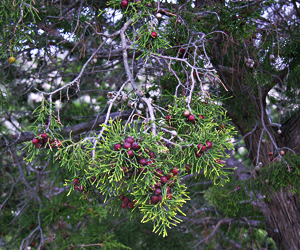Threats
The coastal dunes with Juniperus spp. priority habitat in Greece are facing various natural and anthropogenic threats summarized in decreasing order of importance below:
Threat 1 Restricted natural regeneration
Studies have shown that natural regeneration of Juniperus oxycedrus ssp. macrocarpa and other taxa in this genus is restricted due to several factors. These factors include slow growth, low seed viability and/or difficulty in germinating as well as the imbalance in the female/male ratio of the stands. Therefore, this project aims to deal with these problems for all the sites in Crete through a range of measures such as in situ and ex situ conservation actions (C.3, C.4 and C.8) which will be based on an investigation of the Juniper population composition and structure (action A.3).
Threat 2 Tourism
All coastal dune Juniperus spp. habitats in Greece are greatly affected by the tourism impacts, Crete is no exception. Visitors amongst other things, cause habitat degradation through, trampling and camping, pose a fire risk, and litter. The damage to the habitat and in particular to the Juniperus species is evident as visitors, due to lack of awareness, often consider parts of the trees dead, thus, cutting wood for fires or unintentionally damaging the root systems. Therefore, this project aims to deal with these problems through a range of concrete conservation actions (C.1, C.2, C6 and C.7) which incorporate raising awareness and limiting visitor spatial distribution away from the habitats. Infrastructure will also be provided to limit visitor impacts, for example pollution from littering, through the provision of rubbish bins (action C.6) etc. All these actions will be based on the result of the visitor impact assessment which will be undertaken on all Cretan sites (action A.5). In Cretan sites, visitors range from mass tourism day trippers (eg Chrysi, GR4320003) to individual visitors who usually undertake free camping (eg Elafonisi, GR4340015) rendering the visitor management actions applicable to all habitat sites in Greece.
Threat 3 Lack of public awareness
Coastal dune with Juniperus spp. habitats in Crete are highly valued for their beauty and recreation potential. Their users however, lack awareness of the habitats conservation value as well as the negative impact their actions may be causing on the habitat itself. Lack of awareness is resulting in unsustainable activities such as camping, fires, woodcutting, trampling and general habitat damage. Lack of awareness exists also amongst stakeholders responsible for the management and activities taking place at the sites, for example tourism operators and local authority officials. This is underpinned by the lack of documented and communicated information on appropriate conservation and management techniques for this priority habitat. Therefore, this project aims to deal with this threat through a range of awareness raising activities, built within a multi-stakeholder communication strategy (See Section D) and active stakeholder consultation and engagement from the onset of the project (actions A.6, C2, C.6 and C.7).
Threat 4 Solid waste disposal
Coastal dune with Juniperus spp. habitats in Crete are threatened by uncontrolled solid waste disposal, which is occurring through illegal fly-tipping as well as by visitor littering. This is a serious threat to the habitats as the material disposed is in many cases not biodegradable and may even incorporate chemical and toxic substances. Pollution as a result of fly-tipping is a serious issue as leaching can occur into the soil and water subsequently affecting the health of the habitat. Therefore, this project intends to deal with this threat in all Cretan sites by removing the waste to start with (action C.2) and subsequently providing the means for example rubbish bins (action C.6) and visitor information (action C.7 and D.1) to ensure that the sites are kept clean.
Threat 5 Fire
Fire is a major threat to all terrestrial ecosystems in Greece. The coastal dune with Juniperus spp. habitats in Greece are no exception. In Crete, the use of fire is a common practice for rangeland improvement which in many cases cause extended damages in neighboring areas. Additionally, fire can be caused by uncontrolled camping fires. The sites that are under great risk are those where junipers are next to or in mixed stands with pines (e.g. Gavdos, GR434 0013)). Therefore, this project aims to deal with this threat through a range of awareness raising activities (actions C.7, D.1 and D.3).
Threat 6 Wood cutting
Woodcutting of the Juniperus species is a serious threat to coastal dune with Juniperus spp. habitats in Crete. Woodcutting, mainly dry branches of individual trees, is a common activity undertaken by most campers on the sites for lighting camping fires. This phenomenon is mainly due to the lack of awareness of visitors which consider the dry looking branches of the Juniperus trees as dead. However, due to the slow regeneration and growth rate of these species the damage can be significant. Therefore, this project aims to deal with this threat by raising awareness and prohibiting camping as well as the lighting of fires on all sites in Crete (actions C.7 and D).
Threat 7 Grazing
Freely grazing is the most common grazing practice in Crete and in the Aegean islands. The target habitat in many sites is bordering phryganic rangelands. Although the target habitat is not producing enough foliage there is much evidence of animal grazing where sheep flock and goat herd densities are notably high. Grazing and browsing activity influences vegetation distribution patterns significantly, which consequently have a bearing on dunes characteristics, dynamics and stability. The main grazing impact on the target habitat is the serious reduction in the regeneration of Juniperus spp and very often leads to accelerated wind erosion of the dune system. Therefore, this project aims to deal with this threat by enhancing the regeneration of Juniperus and the In situ conservation of keystone species (actions C.3 and C.4).









